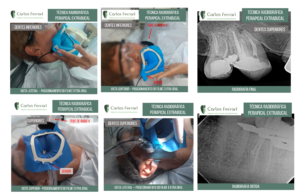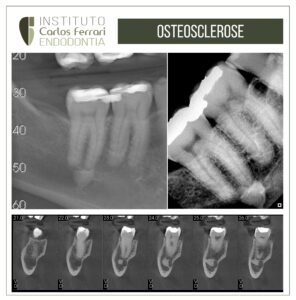Selective endodontic retreatment. Case report.
Patient sought care complaining of pain in the upper right gingival region. In the history, she reported previous endodontic treatment. On clinical examination, gingival edema, besides pain on percussion and palpation on tooth 16. On radiographic examination, root canal treatment with obturation with apparent good quality and diffuse radiolucent image on the MV root. CT scan confirmed the finding, also indicating a possible untreated MV2 canal. The other roots had periapical tissue with no evidence of inflammation. The patient reported that the treatment had been performed with absolute isolation.
In certain situations, we can perform retreatment only in the root where the infectious process causing the pathology is located (Nudera, 2015). For this decision is necessary tomographic evaluation of the periapical bone aspect of all roots and especially if the previous treatment was performed within the basic criteria of asepsis, especially the absolute isolation.

Selective endodontic retreatment
In: Nudera.Selective Root Retreatment: A Novel ApproachJ Endod 2015; 1-7.
Summary
Root canal retreatment is traditionally considered an "all or nothing" treatment approach. It is usually recommended that all restorative and filling materials should be removed from all roots, regardless of the presence or absence of periapical pathology. In contrast, surgery to endodontics is not viewed as an "all or nothing" treatment approach, Traditionally, only the diseased root(s) are addressed by apical resection and apical filling.
The use of cone beam computed tomography allows a more accurate assessment of the periapical condition of individual roots. This information has introduced a new, conservative treatment alternative for previously endodontically treated teeth with multiple roots showing post-treatment disease. This new approach is called selective root retreatment. Advanced imaging allows the clinician to make predictable treatment decisions regarding the presence or absence of periapical pathology of individual roots, rather than making assumptions about the tooth as a whole. Selective root retreatment combines the non-surgical retreatment treatment approach with the selectivity of surgical root resection. In this way, retreatment can be limited to a single root or roots clearly showing periapical pathology while leaving the root(s) with no visible or perceived pathotic sign untouched.
Selective endodontic retreatment.





